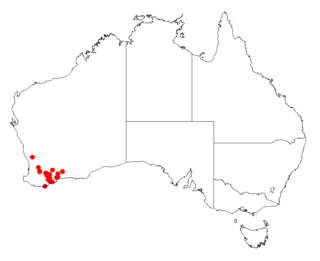
Acacia alata, commonly known as winged wattle, is a species of flowering plant in the family Fabaceae and is endemic to the south-west of Western Australia. It is a much-branched shrub, its phyllodes continuous with the branches and arranged on either side of them, flowers arranged in racemes of 2 spherical heads of white to golden-yellow flowers, and flat, curved, crusty pods 20–80 mm (0.79–3.15 in) long.

Acacia nigricans is a species of wattle which is endemic to an area on the south coast of Western Australia.

Adenanthos pungens, the spiky adenanthos, is a species of shrub in the family Proteaceae. It is endemic to the south-west of Western Australia.
Calothamnus gracilis is a plant in the myrtle family, Myrtaceae and is endemic to the south-west of Western Australia. It is a spreading shrub with upright foliage, common in heath within its range. It has long, thin leaves and produces dark red flowers at different times of the year, depending partly on rainfall. It is similar to Calothamnus gibbosus but lacks the corky bark on the older branches of that species and its flowers and fruit are not as deeply embedded in the bark.

Acacia andrewsii is a shrub belonging to the genus Acacia and the subgenus Phyllodineae that is endemic to western Australia.

Acacia erinacea, also known as prickly wattle, is a shrub belonging to the genus Acacia and the subgenus Phyllodineae that is native to Western Australia.

Acacia laricina is a shrub belonging to the genus Acacia and the subgenus Phyllodineae that is endemic to south western Australia.

Acacia merrallii, commonly known as Merrall's wattle, is a shrub belonging to the genus Acacia and the subgenus Phyllodineae that is endemic to south western and southern Australia.

Acacia prainii, commonly known as Prain's wattle, is a shrub or tree belonging to the genus Acacia and the subgenus Phyllodineae endemic to Australia.

Acacia pycnocephala is a shrub of the genus Acacia and the subgenus Phyllodineae that is endemic to south western Australia.

Acacia ancistrophylla is a shrub of the genus Acacia and the subgenus Plurinerves that is native to several areas on southern Australia.

Acacia colletioides, commonly known as wait-a-while, pin bush and spine bush, is a shrub of the genus Acacia and the subgenus Plurinerves that is native to Australia.

Acacia dissona is a shrub of the genus Acacia and the subgenus Plurinerves that is endemic to an area of south western Australia.

Acacia flavipila is a shrub of the genus Acacia and the subgenus Plurinerves that is endemic to an area of south western Australia.

Acacia lobulata, commonly known as Chiddarcooping wattle, is a shrub of the genus Acacia and the subgenus Plurinerves that is endemic to a small area of south western Australia. It was declared as rare flora in 1997 and is now listed as endangered under the Environment Protection and Biodiversity Conservation Act 1999.

Acacia oswaldii, commonly known as boree, umbrella wattle, umbrella bush, whyacka, middia, miljee, nella and curly yarran, is a shrub or tree of the genus Acacia and the subgenus Plurinerves.

Acacia sclerophylla, commonly known as the hard-leaf wattle, is a shrub of the genus Acacia and the subgenus Plurinerves and is endemic to southern parts of Australia.

Acacia amputata is a species of flowering plant in the family Fabaceae and is endemic to the south-west of Western Australia. It is a much-branched, spreading shrub with spiny branchlets, small bipinnate leaves, light golden flowers arranged in spherical heads of 10 to 20, and wavy or coiled pods up to 15 mm (0.59 in) long.

Acacia guinetii, commonly known as Guinet's wattle, is a shrub of the genus Acacia and the subgenus Pulchellae that is endemic to a small area along the coast of western Australia

Acacia lasiocarpa, commonly known as Panjang or Pajang or glow wattle, is a shrub of the genus Acacia and the subgenus Pulchellae that is endemic to Western Australia.






















